EXPLORATION
Exploration is a relatively easier and beginner friendly profession for CMDRs to start in Elite Dangerous. Exploration entails the search of valueable planets, research on exo biology lifeforms, and the visitation of many iconic known star systems, nebulae and Elite Dangerous lore points of interests.
TABLE OF CONTENTS
- Different Roles
- Exploration Ship Builds
- Exploration Modules
- Fuel Scooping
- The Galaxy Map
- The Codex
- The Surface
- Other Resources
DIFFERENT ROLES

In the Exploration profession, an explorer can take on 3 unique roles
- Bubble Explorer
- Sightseer Explorer
- Deep Space Explorer
A bubble explorer, or otherwise called short-range explorer, is a pilot who likes to discover planets, stars and other unknown things, inside the bubble. Almost every system in the bubble has been discovered and seen by other pilots and the chances you’ll find something new is close to zero. However, there are still a lot of things to discover for yourself.
- It is recommended that you start with this role until you get the hang of jumping to systems, scanning planets and exobiology before taking on other exploration roles.
- This role is not to be confused by a bubble taxi. Which is a ship with the highest jump range possible to go from A to B within the bubble.
A sightseer explorer visits discovered systems and planets all over the galaxy. They often use the codex or a 3rd party sightseeing website to plan their trip, to see things with their own eyes. All expeditions are sightseeing trips, as all the waypoints are previously discovered by other pilots.
A deep space explorer is an explorer that goes out, away from the bubble into the unknown. With only a handful of actual target systems, if any at all, in the galaxy, they go out and explore systems nobody has ever been. Using their tools to scan and map planets and stars, visited for the first time in human history.
EXPLORATION SHIP BUILDS
Here you can see suggestions for exploration ship builds.
EXPLORATION MODULES
Exploring the galaxy may seem relaxing, but can be quite deadly if you are unprepared. Stellar masses like black holes, neutron stars and white dwarfs, and planets with high gravity can make your journey difficult. To make sure your ship can handle a long journey, there are modules you have to carry:
Fuel scoop
You will not get far without it. This module allows you to replenish the ship’s fuel reserves. This module is also necessary to do a neutron boost.Shield Generator
Provides a buffer if you accidently bump into foreign bodies like exo-biology life forms and prevents damage taken when landing on a high-gravity planetary body.Auto Field-Maintenance Unit (AFMU)
This module repairs other modules when they get damaged due to overheating your ship. An AFMU can not repair itself, therefore it is recommended to bring at least 2 AFMU modules.Detailed Surface Scanner (DSS)
This module allows you to map planets and obtain information about the planet's composition.
Then there are recommended modules that are also necessary, but are not required:
Guardian Frame Shift Drive Booster
The Guardian Frame Shift Drive Booster is a module that boosts a ship's jump range. This module can be unlocked from Guardian Technology Brokers. The required items needed are:- 1 Guardian Module Blueprint Fragment
- 21 Guardian Power Cell
- 21 Guardian Technology Component
- 24 Focus Crystals
- 8 HN Shock Mount
A guide to unlocking this module can be found here.
Planetary Vehicle Hangar
The Planetary Vehicle Hangar allows you to disembark in your Scarab SRV to get a closer look at the things you’ve found on the surfaces of planets. This is another way of obtaining raws if you don't have a mining laser equipped on your ship.Mining Laser
Mining lasers allows you to shoot a laser beam at several species found in Notable Stellar Phenomenae. When interacted by a thermal weapon, they will behave differently where all of its actions can be documented. A mining laser is also used to collect raw materials from asteroid belts, mostly to replenish synthesis needed for AMFU or Life Support.Supercruise assist
This module allows you to sit back and relax while your ship flies to a planet or other point of interest that is far away. It will automatically go into orbit of a planet, or jump you into a point of interest, such as a Notable Stellar Phenomena.Repair Limpet Controller
In the event where your hull gets damaged, either through excessive heat damage or were involved in a heavy collision, you can repair your hull strength with this module. Repair Limpets can also repair canopies if they are not broken.Heat Sink Launcher
Heat Sinks will instantly cool your ship down to the point where frost will cover your canopy. In the event where heat reaches more than 100% heat, using a heat sink can allow your ship to cool instantly, preventing module damages.
Additionally, there are further optimizations an explorer might bring to enhance their journeys:
Plasma Slug Weapons
Weapons with this experiental are either Rail Guns or Plasma Accelerators. These weapons necessitate the most optimized jump range for exploration to reach the ship's maximum laden jump range. Only advanced explorer will utilize this tactic for the most extreme jumps.Maximizing Efficient Power Plants
Running either Armored or Enhanced Low Power modifications on A-rated power plants can significantly help with your ship's thermal loading. Although undersized A-rated power plants with overcharged modifications can also be used for exploration journeys, a more thermal efficient power plant will always be preferred over the latter.
FUEL SCOOPING
THE BASICS
Fuel is an essential component that powers the ship and without it any Elite Dangerous profession will become fruitless. The indicator of your ship's fuel is located beside the power distributor HUD. There are three components to the fuel gauge:
- the top will have a number indicating the rate of consumption, this number is irrelevant
- the thin line indicates the consumption of one tonne of fuel
- the thick line indicates the total fuel reservoir stored on your ship
Fuel scooping can only be done in supercruise. By orbiting close to the body of a fuel scoopable star, near its exclusion zone, fuel is collected into the ship's total fuel reservoir.

Be careful to not overheat your ship either by:
- fuel scooping too close to the star
- charging your FSD to jump while being too close to the star
- staying stationary for too long

THE EXCLUSION ZONE
You can accidently hit the star's exclusion zone and drop out of supercruise. You'll take some damage and the process of fuel scooping will stop.

To safely exit the star's exclusion zone, you'll need to:
- line up with the escape vector which can be located by:
- target the stellar mass
- line up so that the target reticle on the compass is at the center and is hollow
- line up with the next system target
- be sure not to boost to cause unnecessary heat damage

FUEL SCOOPABLE STARS
Fuel Scoopable Stars are a subset of all the different types of stars you'll find in the Elite Dangerous galaxy. Those scoopable stars are the main sequence star types. To easily memorize the Scoopable Stars types, you can use:
- "KGB FOAM"
- "Oh Be A Fine Girl / Guy Kiss Me"
- "Oh Bollocks, A Friendly Ganker Killed Me."

JET CONE AND INJECTION BOOSTING
You are able to inject raw materials into your Frame Shift Drive to give your ship's jump range a marginal boost. Injection of materials into your ship's Frame Shift Drive can be found in the synthesis tab of the ship's Inventory. Basic, standard and premium injections will boost the ship's jump range by 25%, 50% and 100% respectively.
By using a fuel scoop, you can supercharge your Frame Shift Drive from White Dwarves and Neutron Stars to give your ship's jump range a 50% and 300% jump increase. Neutron Stars are popularized to allow CMDRS to jump to places faster. Supercharging your FSD will damage it overtime.
white dwarf with a 50% boost
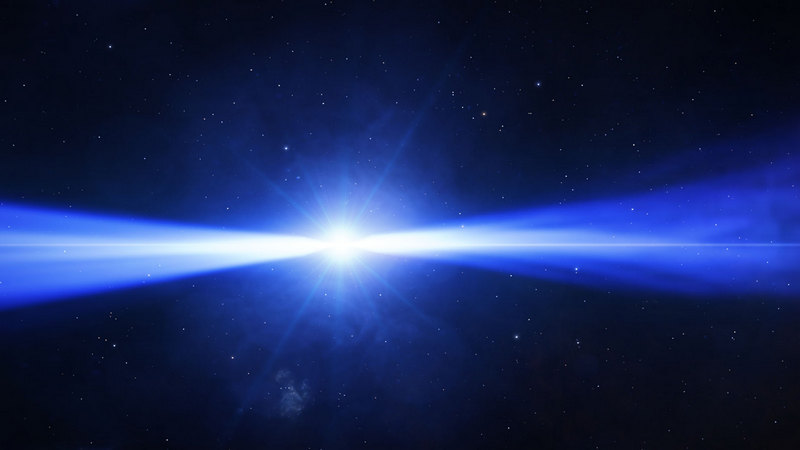
neutron star with a 300% boost
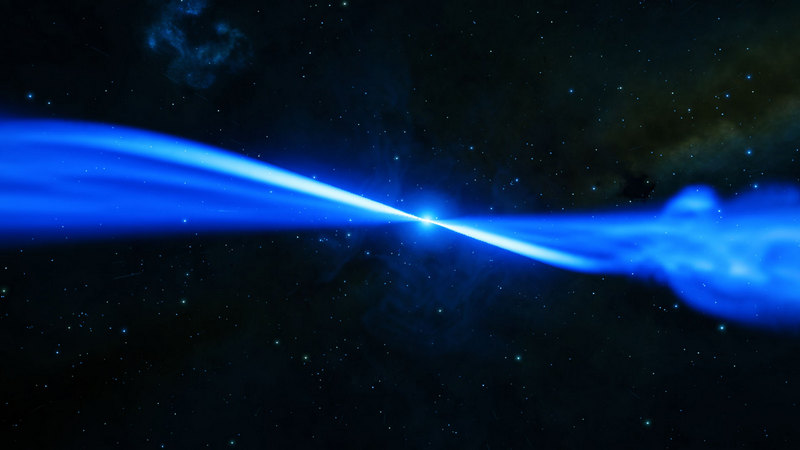
It is generally advised:
- to avoid white dwarves because of its large exclusion zone and its small 50% increase in jump range
- to fly in the same direction as the neutron's jet
You can also run into a White Dwarf or Neutron Star's Jet Cone in its exclusion zone. This is very dangerous place to be, often resulting in eventual death if you are not prepared to escape from one. Incidents like these are rare but can happen.
Spansh's Neutron Plotter is a great tool used by many to plot long distances journeys with a collective network of neutron stars along that path.
GALACTIC RESCUE LINE
Should you find yourself to be in tricky situation, there are two galactic rescue agencies that will help aid you with your trouble at hand.

If you find yourself to:
- have jumped into a non-scoopable star and don't have fuel to jump out
- be on life support because all fuel is depleted
Call the Fuel Rats.
If you find yourself to:
- have the canopy be broken
- have your SRV be stuck in space or stuck on some exo-biology life form
- have damaged your hull severely and have no repair limpet equipped
- be on life support because the module is damaged
Call the Hull Seals.
THE GALAXY MAP

All CMDRs will have access to the galaxy map. Every star existing, known in our astronomy can be found in the Galaxy Map. The Galaxy Map will have a lot of features that can help with route planning, bookmarking, and filterable settings to make searching easier. You'll also have access to view a system's planetary contents when you enter that system. You cannot obtain system data in an unvisited system.
BASICS OF PLOTTING
To plot from your current position to a destination, in your Galaxy Map:
- search for the system name
- select the plot icon, highlighted in white
- remember to filter for fuel scoopable stars and select "apply to route" at the bottom


The number of jumps you will have to make will be shown in the left hand side of the navigations panel.

You can only plot so far in the Galaxy Map's plotter feature.
- If you're using Economical Route you can only plot up to 1,000 Light Years of range
- If you're using Fastest Route you can plot up to 20,000 Light Years of range
BOOKMARKS
Bookmarks are a handy tool to remember a system, or to plan ahead of an expedition. You can add a bookmark to any system or planet of your choice, even stations and fleet carriers! The bookmark can be found in the bookmarks tab in your galaxy map, or as icons above the systems. To bookmark a system, select the system and click on the bookmark icon, highlighted in white.

SYSTEM MAP
When you scan and map a planet, information about that planet or star will become available to you. This information can be found in the system map. On the left hand, second tab you will find all the astronomical information about a planet. For example, the gravity of the planet, it’s surface temperature or atmosphere, its geological composition and its orbital period. You will also find its distance relative to the main star.
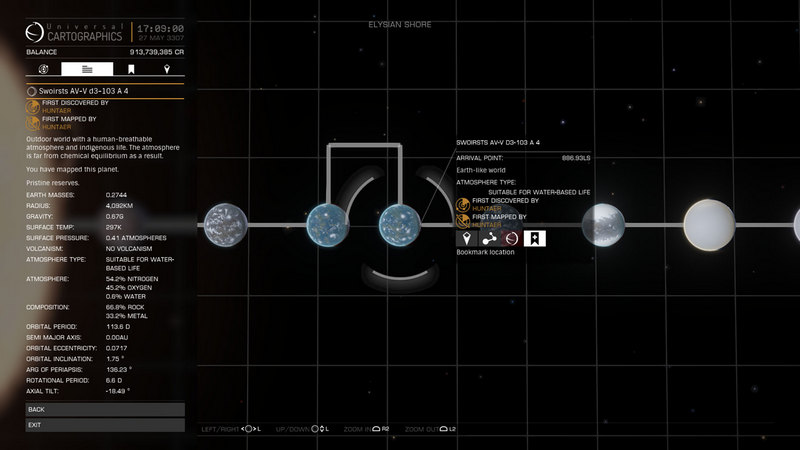
You might also notice two exploration badges, named "First Discovered" and First Mapped". These exploration badges credits the CMDR that first discovered and/or first mapped the planets.

If you are exploring within the bubble, the system map will indicate planetary bodies that are landable, non-landable, has an atmospheric world, is a landable atmosphereic world, is landable with settlements.
SCANNING AND MAPPING
When entering systems, the system map will not be filled with planetary information. You are required to scan for these planetary bodies and its information using one the different methods:
- by targeting the body within 1,000 Ls of your proximity
- by Discovery Scanner
- by Full Spectrum System Scanner
- by Detailed Surface Scanner
Using the Discovery Scanner, Full Spectrum System Scanner, and Detailed Surface Scanner requires you to be in analysis mode.
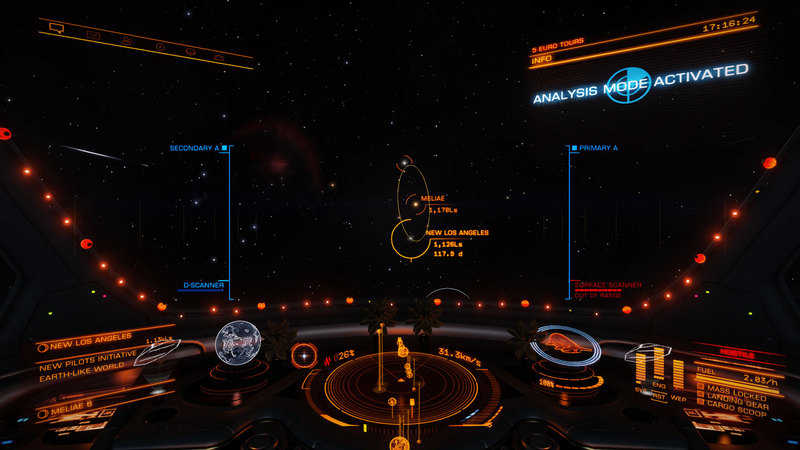
DISCOVERY SCANNER
The Discovery Scanner, mostly called as the "D-Scanner" is a firegroup bounded tool that scans planets within proximity to your ship. The Scanner will emit a loud honk after completing the scan, which is why explorers also commonly refer this as "honking". Honking will automatically reveal all stars in the system and they no longer need scanning. It will also tell you how many planets and stars (called bodies, as in celestial bodies) there are in the current system.


FULL SPECTRUM SYSTEM SCANNER
After honking the system, you can now start scanning planets from a distance, using an on-board telescopic module called the Full Spectrum System Scanner (FSS). The FSS lets you tune certain frequencies used to search for certain planets and signals. You have to be idle in supercruise to be able to use this module, so throttle down to 30.0 km/s.

By sliding across the the spectrum, tuning to different frequencies, you are able to then focus on the source of the frequency. Some sources may require additional focusing as the source might be too close to other sources.
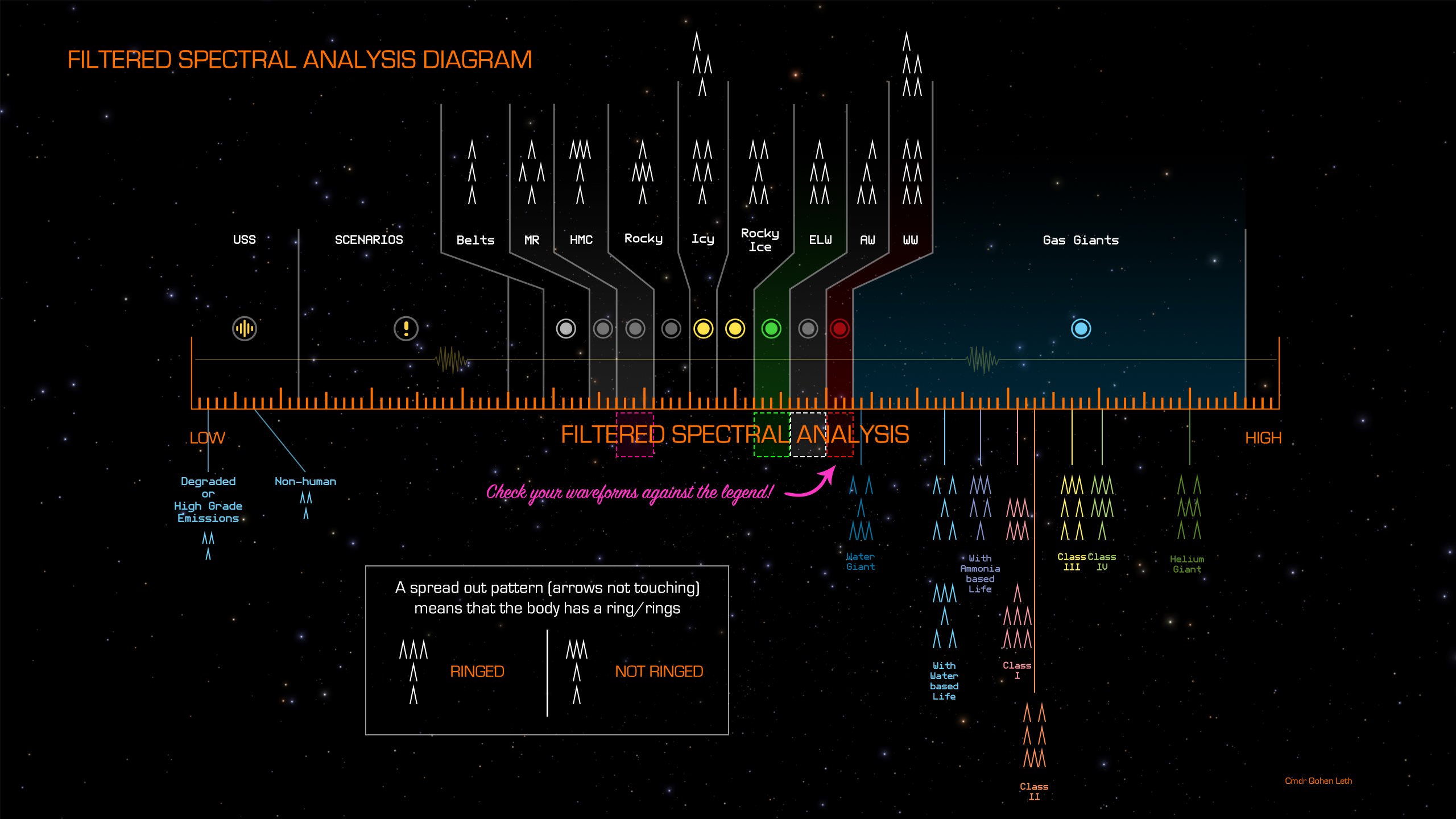
DETAILED SURFACE SCANNER
To map a planet, fly closer to a planet and activate the Detailed Surface Scanner (DSS). The DSS allows you to fire probes at a planet to reveal even more information, such as settlements, volcanic activity or even biological points of interest. Aim the probes all around the planet using gravity and scan it to 100%. You have to be idle in supercruise to be able to use this module, so throttle down to 30.0 km/s.

To make a bit of extra cash from your surface scan, fire no more than the amount of “Efficiency Target” probes. You can find the information on the bottom right of your screen in the DSS. Different planetary masses require different amounts of probes to obtain the Efficiency Target.
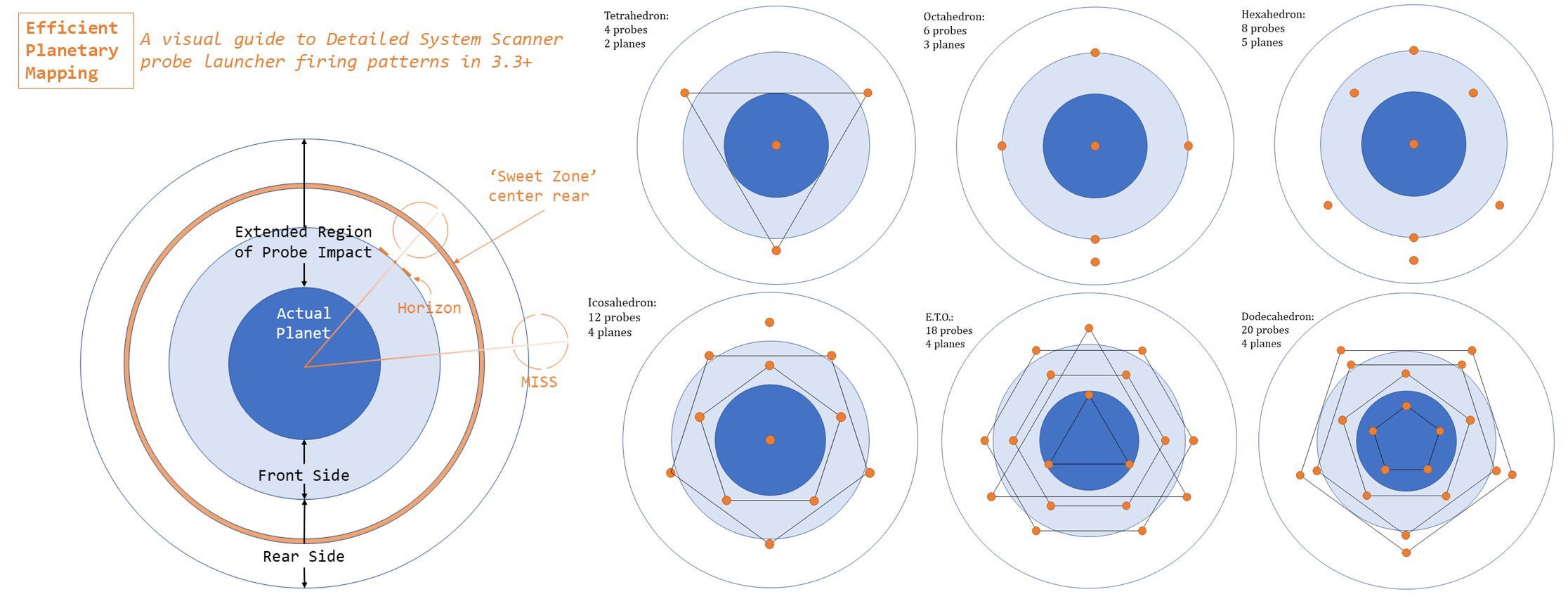
If you’d like to know how many credits you can earn by scanning, have a look at this infographic. This infographic assumes you hit the efficiency target successfully.
- FSS -- Full Spectrum System Scanner
- DSS -- Detailed Surface Scanner
- FD -- First Discovery, this means you are the first to ever see or probe it
| Planet Type | FSS | FSS+DSS | FSS+FD+DSS |
|---|---|---|---|
| Earth-like World | 270,000 | 1,100,000 | 3,200,000 |
| Terraformable Water World | 270,000 | 1,100,000 | 3,200,000 |
| Terraformable HMC | 160,000 | 680,000 | 2,000,000 |
| Ammonia World | 140,000 | 600,000 | 1,700,000 |
| Terraformable Rocky Body | 130,000 | 540,000 | 1,600,000 |
| Water World | 100,000 | 420,000 | 1,200,000 |
| Metal Rich Body | 30,000 | 130,000 | 380,000 |
| Class II Gas Giant | 28,000 | 120,000 | 340,000 |
| High Metal Content | 14,000 | 60,000 | 170,000 |
| Class I Gas Giant | 3,800 | 16,000 | 46,000 |
| Class IV Gas Giant | 1,100 | 4,700 | 13,000 |
| Class III Gas Giant | 1,000 | 4,000 | 12,000 |
| Class V Gas Giant | 1,000 | 4,000 | 12,000 |
| Helium-Rich Gas Giant | 900 | 3,800 | 11,000 |
| Gas Giant w/ Water-based Life | 880 | 3,700 | 11,000 |
| Water Giant | 670 | 2,800 | 8,000 |
| Rocky Ice Body | 500 | 1,800 | 5,100 |
| Ice Body | 500 | 1,600 | 4,500 |
| Rocky Body | 500 | 1,500 | 4,300 |
FINDING EARTH LIKE WORDS
As you probably can tell, First Discovered, Detailed Surface Scanned and Full Spectrum System Scanned Earth Like Worlds yield the most amount of credits to an explorer. There is an easy way of searching for Earth Like Worlds in the black. Generally A type stars, specifically A7 through A9 type stars offer the best chance of finding Earth Likes, however set a filter for F type stars as those offer the highest chances.
Each star system in the procedural generation creates a string of letters and numbers that actually means something.
- Praea Ain MA-A D 1160
The bold and italicized letter is called the system mass code. It goes from A (least massive) to H (most massive) and denoted the TOTAL mass of the system. Most main sequence star types fall into a single mass code, specifically F-type stars are NEARLY ALL mass code D. The exception here is G-type stars which split roughly 50-50 between mass codes C and D. Here's a dataset containing the distribution of mass codes and star types.
THE CODEX
The Codex is a collection of your game statistics, game discoveries, and in-game guides and lores to help you with your journey. The codex has a lot of information about:
- Commander
information about you and your game statistics - Discoveries
all discoveries found around the galaxy, divided into 42 galactic regions. - Knowledge Base
all knowledge about the empire, federation, thargoids, raxxla etc. - Pilot’s Handbook all useful information about careers, maps etc.
THE COMMANDER

The Commander section is divided into three sub-sections:
- Session Log
The session log keeps track of your current play session's jumps, discoveries, sales, material gathering. - Stats
The stats section has all the stats about your commander's progression. - Archive
The archive holds all scanned data from tourist beacons, data links on megaships and settlements.
DISCOVERIES

The discovery section is a collection of reported and confirmed discoveries found within their own galactic regions. An interactive map will show what sorts of exobiology lifeforms, planetary body masses exists in that region. The discoveries list will show up to three sections:
- Astronomical Bodies
Astronomical Bodies discoveries include Stars, Gas Giants, Terrestrial Planets. - Biological and Geological
Biological and Geological discoveries include Geology, Anomalies and Organic Structures. - Xenological
Xenological discoveries include discoveries of Guardian and Thargoid related structures.
KNOWLDGE BASE

The Knowledge Base section will have historical documentation of the main superpowers, other races of species, major industrial corporations and independent factions like the Dark Wheel and Raxxla.
PILOT'S HANDBOOK

The Pilot’s Handbook is a collection of mini in-game guides and information packets to help the player progress in Elite Dangerous covering:
- Mining
- Piracy
- Mercenary Work
- Xeno Hunting
- Maps
- Fleet Carriers
- Exploration
- Trade and Smuggling
- Bounty Hunting
- Salvage and Rescue
- Crime and Punishment
THE SURFACE

In Horizons, you have the ability to access landable planets and explore the planet's surfaces. In Odyssey, you have the ability to visit planets with tenuous atmosphere. There exists multiple organic structures that can be found, researched and explored throughout the Elite Dangerous universe.
GLIDING AND LANDING
To be able to land on surfaces of planets either to disembark on foot or explore on surface recon vehicles (SRV's) you will need to perform a glide before finding a suitable area to park your ship. To successfully perform a glide, you must maintain an angle of descent between 5º to 60º degrees.

You'll know a couple of things that'll show on your altitude meter when you start to glide:
- OC (Orbital Cruise)
This indicates the level where it is safe to orbit the planet, this is the uppermost layer of the planet's exclusion zone area - DRP (Drop Level)
At this level, the ship will drop from supercruise and enter a glide
You'll also notice a bar on the right side of the HUD as well as coordinates, a heading and the planet's gravity indicator.
- The Descent Bar
This bar indicates the rate of ascent or descent of your ship. Too fast of a descent will force you out of the glide. - Coordinates & Headings
Just like aviation here on Earth, you'll be given a set of coordinates and a heading to locate your position. - Gravity
Every planet will have a different gravitational reading, all measured in relation to earth's gravity, 1 G is one earth gravity. Make sure to perform a shallower glide if the gravity is higher than 1 G. On high G landing, you may have to use your main thrusters to slow down your ship's rate of descent.

When finding an area that's relatively flat so your ship can land, use the minimap to help guide you to a flat area. The minimap will only change when you have your landing gear deployed. When there is a suited area to land, the indicator of your ship will illuminate. Steady your ship and land. In Odyssey, the auto docking feature can assist you to auto land on planetary surfaces.

PILOTING THE SRV

There are two Surface Recon Vehicles accessible to be used to roam on surfaces of planets. The SRV Scarab and the SRV Scorpion, only available to Odyssey CMDRs. To disembark into your SRV, select the SRV hanger and deploy it.

Now you're in your SRV. There are some things to note when you are driving the SRV:
- the cluster HUD is similar to your ship's HUD
- you have only one tonne of fuel
- moving away from the ship will allow you to use the SRV's boost and turret
- you have a radar scanner on top of your minimap to scan for nearby anomalies

You can also use the camera in the SRV’s turret, called Turret Mode. In Turret Mode view allows you to view 360º around your SRV, like a tank. You can use the turret to shoot your Dual Plasma Repeaters or scan objects with your Composition or Data Link scanners.

There are some behaviours your ship might do:
- if you are too far from your ship, it will disembark
- you can recall and disembark your ship at your command
- you can board back onto the ship while it either has landed or hovering above the ground.
To return to your ship, drive under the SRV hatch, which is marked by an orange hologram on the underside of your ship. When you’re under the hatch, the Board Ship light will be on. You can find this on the bottom right of your HUD. Select Board Ship to board your ship. You can also transfer cargo from your SRV to your ship and vice versa using the Transfer Cargo option.

ENGAGING THRUSTERS
To engage your engines after you've landed, all you need to do is to press your upward vertical thrusters. After holding it, you'll be discharged from the ground and are now able to fly off elsewhere. To engage supercruise, you need to leave the planet's mass lock zone, which is generally 2 - 3 km from the surface, and be faced above a 40º pitch angle to safely wake out of the planet.

OTHER RESOURCES
EDSM (Elite Dangerous Star Map)
A fantastic website offering a huge amount of information on the Galaxy.ED Astrometrics
Ever wondered where in the galaxy everyone is, or what places haven't been explored? The Astrometrics website provides maps of the galaxy showing everything we know about the galaxy through a lot of different lenses.Spansh
Spansh is a route plotter for traversing the galaxy. You can use it to work out the best way to get across the galaxy using Neutron Stars, or maximise the money you make exploring known regions, or helping you plot your fleet carrier journey efficiently.
- Scenic Route Finder
A website with a Scenic Route Finder. A handy tool to help prepare a route or an expedition.